| |
 |
Seaside |
Florida |
USA |
Horizontal Dial |
Dial 551 |
| A large horizontal dial of cement and gravel within a 30 foot diameter hedge. Unfortunately, this dial no longer exists and was lost to commercial development. |
| |
| |
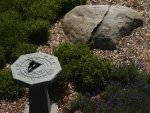 |
Sheboygan Falls |
Wisconsin |
USA |
Horizontal Dial |
Dial 550 |
| A 20 inch octagonal dial of bluestone on a 28 inch high base. The gnomon matches the latitude angle and the hour lines are approximate for a generalized geographic area. |
| |
| |
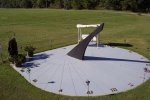 |
Claremore |
Oklahoma |
USA |
Horizontal Dial |
Dial 549 |
| A 24x36 foot all-concrete horizontal dial with marks to indicate summer solstice and equinox. Located on private property; contact owner Dan Wilson to arrange viewing. |
| |
| |
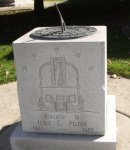 |
Delphos |
Ohio |
USA |
Horizontal Dial |
Dial 548 |
| A horizontal dial on a stone block. Dedicated to Leslie C. Peltier, recognized as "World's greatest non-professional astronomer" by Harvard Observatory. Dial sits atop a stone block, possibly marble. |
| |
| |
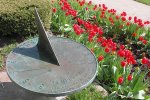 |
Elburn |
Illinois |
USA |
Horizontal Dial |
Dial 547 |
| A 30-inch diameter cast bronze dial with natural patina after more than 30 years exposure. Replaces a "garden" dial donated by Class of 1967 but destroyed by vandals. Dial is located on campus of private school but available for viewing during daylight hours. |
| |
| |
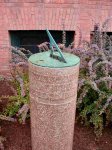 |
Norwich |
Connecticut |
USA |
Horizontal Dial |
Dial 546 |
| A well-patinaed horizontal dial placed atop a stone column. Dial sits atop a cast aggregate column. |
| |
| |
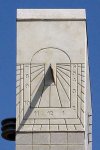 |
Lampeter |
Pennsylvania |
USA |
Vertical Dial |
Dial 545 |
| A 32x64-inch cast stone vertical declining dial located 25 feet up a vertical column at the school's entrance. An EOT plaque is located below the dial. |
| |
| |
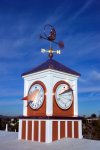 |
Tucson |
Arizona |
USA |
Vertical Dial |
Dial 544 |
| Four vertical dials on the faces of a 100-inch tall redwood cupola on the roof of a private residence. The 21-inch dial faces are kiln-fired porcelain on steel; the bezels and gnomons are copper. The dials are longitude corrected for MST. Three dials have solar noon marks. |
| |
| |
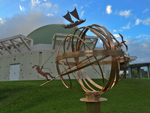 |
Kaneohe |
Hawaii |
USA |
Armillary Sphere |
Dial 543 |
| A 32-inch diameter bronze armillary dial with extensive Polynesian-themed motif. An integral plaque provides corrections for EOT and longitude within HST. The armillary includes ten bronze rings: horizon; solstitial colure (meridian); equinoctial (equator); Tropic of Cancer; Tropic of Capricorn; Arctic circle; Antarctic circle; "prime vertical circle" perpendicular to the meridian circle and horizon that spans from east to zenith to west; equinoctial colure perpendicular to meridian circle and equator passing through the north and south poles; and an "upright ring" inscribed with Zodiacal signs between the prime vertical and equator. |
| |
| |
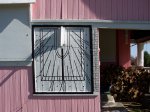 |
Springfield |
Vermont |
USA |
Vertical Dial |
Dial 542 |
| A 52x55 inch painted wood vertical dial designed and built by Russell Porter. The wood gnomon is stabilized by copper sheet. Available for viewing at the summer Stellafane Telescope Makers conference or by arrangement by email with owner. |
| |
| |
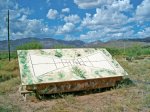 |
Gila |
New Mexico |
USA |
Polar Dial |
Dial 541 |
| An 8x4 foot painted plywood polar dial. Contact owner M. Cuff for access. |
| |
| |
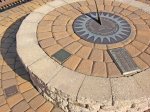 |
Lakewood |
New Jersey |
USA |
Horizontal Dial |
Dial 540 |
| A horizontal dial of cast brass or bronze with a 2-foot diameter dial face showing hours in Roman and Arabic numerals. Coordinates and EOT corrections are shown as is the university motto, "Georgian Court: Bonitas, Disciplina, Scientia." Sundial face is also the sun in a scale model of the solar system, with the planets depicted in brass plaques placed at to-scale distances. |
| |
| |
 |
Halton Hills |
Ontario |
Canada |
Analemmatic Dial |
Dial 539 |
| A stone analemmatic dial with engraved seasonal dates and brass hour markers. The dial is located in Lucy Maude Montgomery Garden, built to celebrate the author of the Anne of Green Gable stories and who lived in Norval, now known as Halton Hills. |
| |
| |
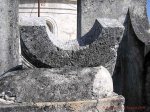 |
Merida |
Yucatan |
Mexico |
Equatorial Dial |
Dial 538 |
| Generally identified as an equatorial, this stone cylindrical cavity dial uses the extremities of the semicircular dial plate as two independent styles. The dial face is marked with six equally-spaced hour lines with minor subdivisions. The east style casts the 6 AM to noon shadow while the west style casts the noon to 6 PM shadow. No construction date is give but is likely 18th century or earlier. |
| |
| |
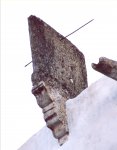 |
Merida |
Yucatan |
Mexico |
Vertical Dial |
Dial 537 |
| This is south-facing vertical or scratch dial with horizontal gnomon and located on the roof at the front of an early church monastery cloister. The stone dial is approximately 3 feet square. The north face is similarly inscribed. This is among the earliest sundials in North America. |
| |
| |
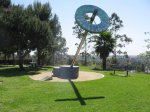 |
Culver City |
California |
USA |
Equatorial Dial |
Dial 536 |
| Located near the edge of a hill in Culver Park, this dial commands a fine view of the surrounding communities. The equatorial dial face is a six foot diameter, six inch thick brass ring supported by a 24 foot long steel gnomon six inches in diameter. The gnomon is anchored in a concrete oval-shaped base covered with tile and mosaics. The base and three surrounding water-drop shape ovals are inscribed with the word "Time" in the 12 languages spoken in Culver City. Ballona Creek, visible from the sundial, once provided transportation, food and recreation for a thriving native American population and later for Spanish-origin ranch owners. The dial north face has the 1:00 hour line at the bottom for Daylight Savings Time while the south face has the 12:00 hour line at the bottom for standard time. A bronze plaque states time is read from the center of the gnomon shadow and briefly discusses the equation of time. The dial is not longitude corrected and indicates local apparent time. |
| |
| |
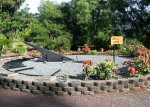 |
Pearl City, Oahu |
Hawaii |
USA |
Horizontal Dial |
Dial 535 |
| A 28 foot stone horizontal dial with 8 foot high black wood and fiberglass gnomon located in a children's Sundial Garden. Hour markers are Roman numerals cast into concrete blocks. Dial is screened by koa and lonomea trees. |
| |
| |
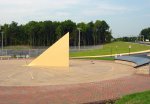 |
Woodbridge |
Virginia |
USA |
Horizontal Dial |
Dial 534 |
| A large 62 foot diameter horizontal sundial of grey concrete and brick with a 10 foot high steel gnomon. The dial was designed to memorialize the victims of the 9/11/2001 terrorism and includes four inlaid plaques on which the gnomon shadow falls at 8:45, 9:03, 9:37 and 10:07 AM, the times of the four air crashes. Hour markers are inset brass Roman numerals. The hour lines and NESW compass rose are 2 inch wide inset brass strips. |
| |
| |
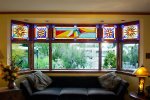 |
Tucson |
Arizona |
USA |
Vertical Dial |
Dial 533 |
| A declining vertical stained glass "Gecko" sundial 58 x 20 inches consisting of 153 colored glass pieces and exterior rod gnomon with triangular base. Paintings on 11 glass pieces use vitreous kiln-fired enamels and stains. Dial and four adjacent panels consisting of 540 glass pieces are set in bay window overlooking succulent garden containing additional sundials. Dial glass panel includes painting of a Tucson Banded Gecko stalking fly, a star field, sun face and solar noon mark. Dial declines 27.4? east of south. Contact owner John Carmichael to arrange viewing. |
| |
| |
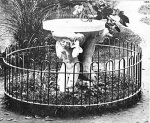 |
Saratoga Springs |
New York |
USA |
Horizontal Dial |
Dial 532 |
| A marble horizontal dial on marble sculpture pedestal. The original bronze Treble Cleft gnomon is now missing. |
| |
| |
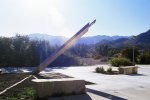 |
Heber City |
Utah |
USA |
Horizontal Dial |
Dial 531 |
| A 51 x 36 foot horizontal dial with a 21 foot welded silicon bronze gnomon standing 14 feet high. The hour lines are copper inlaid in concrete and the hour markers are 4 inch high bronze Arabic numerals. At solar noon, sunlight passing through a slit in the gnomon illuminates the noon marker with a line of sunlight while prisms on the end of the gnomon project rainbows onto this line of light, making the sculpture a seasonal calendar as well as a way to tell time.
Created by sculptor Robert Perless, Sun Dagger functions as a unique celestial observatory to amplify the synergy of man and nature. It also works as a seasonal calendar, celebrating the winter and summer solstices and the vernal and autumnal equinoxes with rainbows crossing the line of sunlight from the gnomon slit and falling on inscribed plaques. |
| |
| |
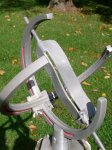 |
Greenville |
Delaware |
USA |
Equatorial Dial |
Dial 530 |
| A 15-inch cast aluminum equatorial sundial designed and built by Richard Schmoyer originally installed in 1972 and replaced in 1985 after theft. A three-dimensional analemmic gnomon corrects for Equation of Time. The observatory is open to the public every weekday morning. |
| |
| |
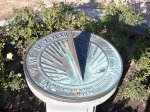 |
Fullerton |
California |
USA |
Horizontal Dial |
Dial 529 |
| This 18-inch cast bronze horizontal dial is located in front of Heritage House, the relocated office and home of early Fullerton physician Dr. George C. Clark. The gnomon edge is tapered to a single style. Dial sits atop a cylindrical cast concrete pedestal 28-inches high. |
| |
| |
 |
Granville |
Ohio |
USA |
Horizontal Dial |
Dial 528 |
| This horizontal sundial is built on a one-meter cube of red granite with a cast bronze gnomon supported by a cast bronze Pegasus modeled by New York artist Carl Paul Jennewein. The dial's plaza location overlooks the village of Granville and the valley beyond to the south. The dial is a tribute to Clifford S. Stilwell (Denison Class of 1912) who was Chairman of the Denison Board of Trustees at his death in 1941. The early B&W photograph of the Pegasus gnomon is courtesy of Denison University Archives. |
| |
| |
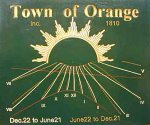 |
Orange |
Massachusetts |
USA |
Vertical Dial |
Dial 527 |
| A vertical sundial built from Eastern White Pine local-grown timber. The dial face is 35x44 inches and the gnomon is a 3 inch long aluminum rod. Hour lines include analemmas and the spring and fall lines are painted different colors with corresponding dates identified. Solstice and equinox lines are shown. |
| |
| |
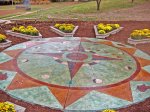 |
Crestwood |
Missouri |
USA |
Analemmatic Dial |
Dial 526 |
| This is a colorful analemmatic sundial 18 feet 6 inches overall diameter built of colored concrete. It is located on the grounds of a private elementary school in an area designated as a Sundial Garden. The sundial is surrounded by elevated flower planter boxes. The E-W markers are 10 feet apart and the date line is marked. The dial face shows the cardinal directions and phases of the moon. Viewing can be arranged by contacting Long Elementary School M-F 8:30 AM-3:15 PM. |
| |
| |
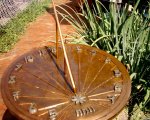 |
St. Louis |
Missouri |
USA |
Horizontal Dial |
Dial 525 |
| This horizontal sundial is a 30 inch diameter and 1.5 inch thick sealed, copper-coated steel plate with cast lead hour markers and weighs 250 pounds. Built in 2002, it was installed in September, 2004 in a private home rear yard. Dial is supported by 6x6 inch pressure treated wood post with 4x4 inch cross frame. Viewing can be arranged by contacting the owner. |
| |
| |
 |
Renton |
Washington |
USA |
Horizontal Dial |
Dial 524 |
| A 44 x 60 foot horizontal dial with 20 foot tall stainless steel gnomon. This may be the largest horizontal dial in the state of Washington. Five colors of concrete define distinct parts of the dial and pathways (the 8 o?clock and 5 o?clock hour lines are walkways between buildings). Other hour lines have concrete benches and stainless steel discs to mark each hour, plus inlaid bronze discs for daylight saving time.
Hour lines have inset disks to indicate the hour, one disk for each counted hour 6 AM to 7 PM. The mid-day N-S hour line features thirteen hour disks; the previous hour has 12 disks and the next hour is marked with two disks. The N-S hour line may include one disk that is also a light to illuminate the gnomon at night. |
| |
| |
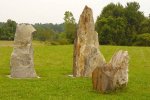 |
Amherst |
Massachusetts |
USA |
Sun Alignment |
Dial 523 |
| On the fields of U-Mass is a work called "sunwheel" that is a modern presentation of an American Indian sun-wheel. A circle 130 feet in diameter has 14 major stones weighing 56 tons, 12 minor stones, and 4 flat stones at the center. 2 major stones mark the N and S cardinal points; a pair of portal stones mark the E and W points allowing an uninterrupted view of sunrise and sunset at the equinoxes; 4 stones mark sunrise and sunset at the solstices; and 4 more stones mark the extreme northern and southern positions of moon rise and moon set. Guided presentations can be arranged by calling 413-545-4311. |
| |
| |
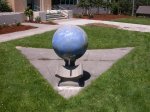 |
Sebastopol |
California |
USA |
Globe or Hemispheric |
Dial 522 |
| The sundial is a cement globe of the earth 28 inches in diameter inclined at 40 degrees, a bit off the site's 38' 20" N latitude. The globe is oriented with the site longitude on the upper meridian so that shadows across the globe represent the true sun angle at that moment. A rod through the globe casts a shadow onto the north polar regions in the summer. At the southern end is a small equatorial dial with hour lines from 8am to 4pm. |
| |
| |
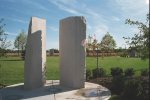 |
Graylake |
Illinois |
USA |
Sun Alignment |
Dial 521 |
| "Sun Pivot" is a set of vertical "gatestones" that allow the viewing of two major solar alignments: The summer sunrise stone is set about 33 degrees north of east while the equinox stone is set due east. The angular cuts in the gatestones allows the framing of the sunrise event above the stones, which are set about 200 feet away in a field of prairie grass. |
| |
| |
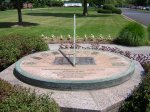 |
Berryville |
Virginia |
USA |
Horizontal Dial |
Dial 520 |
| This lovely horizontal dial was originally located in New York City NY on the grounds of the Doubleday & Co. book manufacturing plant. It was subsequently moved to Berryville VA in 1956, and is now part of Berryville Graphics. The sundial stands about 4 feet high and has a brass reproduction of the Gutenberg Bible of Forty Two Lines (originally produced around 1455) and the hour markers are brass plates of twelve printers' marks from the earliest printers. |
| |
| |
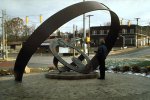 |
Farrell |
Pennsylvania |
USA |
Sculpture/Artwork |
Dial 519 |
| "Rising Rings" is a cast iron band 11 feet high by 17 feet in diameter with a hole that casts a beam of light onto a central ring monument on the equinoxes. The dial was commissioned by Dr. Swraj Paul, a steel mill owner, to honor his daughter Ambika who died in 1968 of leukemia at age four. This monument honors the inspiration her joy of life instilled in her father. At the central of the dial is a cast iron ring that holds a bronze image of her that is illuminated for several days twice a year. On two dates, Ambika's birthday and the anniversary of the mill's re-opening the noon sunlight passes through the circular opening in the larger ring and strikes markers on the inner ring. Miklos Simon created the portrait of Ambika mounted on the smaller ring. |
| |
| |
 |
Redding |
California |
USA |
Horizontal Dial |
Dial 518 |
| When is a bridge not a bridge? When it's almost a sundial. The 217 foot high suspension span called Sundial Bridge wants to be a sundial, and has come very close. The suspension pylon is aligned true north, but unfortunately performs as an inaccurate gnomon with an inclination of 49 deg (for bridge functionality) rather than for the 40.6 deg latitude of the site. The bridge is 700 feet long and weighs 1,600 tons. Funding for the bridge comes from the McConnell Foundation, Redding Redevelopment Agency, Federal Highway Administration, and Turtle Bay Exploration Park |
| |
| |
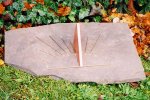 |
Watkins Glen |
New York |
USA |
Horizontal Dial |
Dial 517 |
| A simple horizontal dial made of slate with a copper gnomon. Hour lines are brass rods artfully arranged from 6am to 6pm. The hour lines are corrected for longitude. |
| |
| |
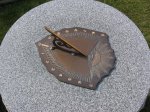 |
Montour Falls |
New York |
USA |
Horizontal Dial |
Dial 516 |
| A beautiful bronze dial approximately 12 inches long in the shape of a shield. Below the gnomon is a rising sun. On first look, the small dial plate appears backward, with AM and PM hours reversed. However, the inclination of the gnomon is about 48 degrees, suggesting that this pedestal mounted dial is really meant to be a south facing vertical dial! The dial sits atop a circular granite pedestal about 2.5 feet in diameter. |
| |
| |
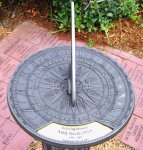 |
Winter Park |
Florida |
USA |
Horizontal Dial |
Dial 515 |
| A 12-inch diameter horizontal bronze dial set on a simple fluted pedestal. The dial face includes hour lines with half hour and ten minute marks and a central compass rose. The gnomon includes an adjusting screw allowing the gnomon angle to be set to the latitude angle.
The dial is located in a small garden area of an elementary school and includes a nearby flagstone bench. The walkway around the dial is of red bricks inscribed with the names of graduating students. Students learned of the death of a 9 year old classmate and through their fundraising efforts helped establish this memorial dial in their schoolyard.
A visitor's pass is required from the administration office before viewing. |
| |
| |
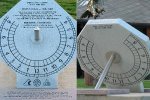 |
Brighton |
Colorado |
USA |
Equatorial Dial |
Dial 514 |
| This equatorial dial is one of the more distinctive Erickson Monument dials. It is octagonal about 4 feet across, made of white granite. It has a supporting stainless steel rod as gnomon. Hours from 4am to 8pm with 15 minute divisions. The hours are not rotated for longitude, placing the 12pm hour directly at nadir. Below the sundial is a plaque containing a graph of the equation of time. |
| |
| |
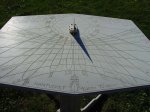 |
Nantucket |
Massachusetts |
USA |
Compound Dial |
Dial 513 |
| A combination of horizontal dial and gnomonic projection dial. The dial is about 2 x 3 feet made of DuPont Corian sitting upon a simple wood pedestal. A small horizontal dial about 8 inches in diameter with a triangular brass gnomon tells Daylight Saving Time using Roman numerals. Then a larger gnomonic dial is inscribed on the remaining surface, telling time from the shadow of the tip of the triangular gnomon. The gnomonic dial has hourly analemmas,telling time using Arabic numbers in Standard Time. Both dial lines are offset for the longitude of 70 degrees west. The gnomonic dial has declination lines for each month. A small analemma on the meridian has the letters of the months, indicating how to read the hourly analemmas depending upon the date. The dial is built to be read from the north, so the user's shadow does not interfere. |
| |
| |
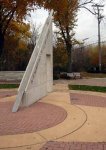 |
Waukesha |
Wisconsin |
USA |
Horizontal Dial |
Dial 512 |
| A large horizontal dial in a circular plaza made of tan concrete and red brick. The concrete gnomon stands about 16 feet tall. No hour lines are drawn on the plaza, but the hours are set in a circular ring at the edge of the plaza. |
| |
| |
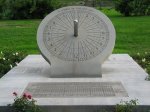 |
Littleton |
Colorado |
USA |
Equatorial Dial |
Dial 511 |
| The Littleton War sundial is an Erickson equatorial polar dial 6 feet in diameter made of light granite with a 3 inch steel rod as gnomon. Time is graduated by hour, half-hour, quarter hours and 5 minute marks over 24 hours. Noon is at the bottom, matching the 105 degree meridian. Designed to be read from the upper surface in Spring/Summer, from the under side in Fall/Winter. A plaque provides the Equation of Time to convert solar time to watch time. Dial is in a beautiful setting. |
| |
| |
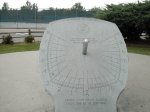 |
Englewood |
Colorado |
USA |
Equatorial Dial |
Dial 510 |
| The Archie Lynn Chase Sundial is an equatorial polar dial. Unlike other monumental polar dials (designed by Erickson Monument Co), the dial face is more of a rounded square than a circular disk. Hours, half hours, quarter hours and five minute lines mark the time from 4am to 8pm. The hour lines are rotated for the site latitude. A steel gnomon rod about 3 inches in diameter casts the shadow. Has a plaque describing the Equation of Time. |
| |
| |
 |
Torre |
Coahuila |
Mexico |
Analemmatic Dial |
Dial 509 |
| An analemmatic dial with major axis of 18 feet built of many different types of stone from the Torre?n Jard?n area, including white and red marble, travertine, yellow and black flagstone, and limestone. Insets of gray stone hold the hour markers from 5am to 7pm. The finished dial has been set in desert plants, native to the region, including: Candelilla, Gobernadora, Lechuguilla, Sangre de drago, Huevo de toro, Biznaga, Pitaya, Corona de espinas, Nopal rastrero, and Cardenche. These are all protected desert species. The dial has a compass rose and six disk-shaped maps at the east and west sides to show the course of sunrise/sunset across the Mexican Republic on the solstices and equinox. |
| |
| |
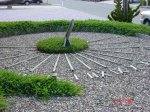 |
Toms River |
New Jersey |
USA |
Horizontal Dial |
Dial 507 |
| A horizontal dial about 22 feet in diameter. The dial base is stone and gravel outlined in shore juniper plants. Treated lumber, now gray through weathering, is used for the both the hour lines and the marking Roman numeral hours. Nicely fashioned with a hub of green junipers in the center surrounding a simple wood gnomon. Builder Richard Perez started off just wanting something a little different?and the sundial emerged in 1992 as the main theme of landscaping. |
| |
| |
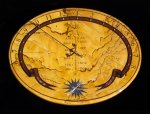 |
Burlington |
Vermont |
USA |
Analemmatic Dial |
Dial 506 |
| A small table top analemmatic dial 31 x 23 inches, made of Rock Sandstone & gold-plated brass. Has sunrise and sunset seasonal markers. Date line divided into weeks. |
| |
| |
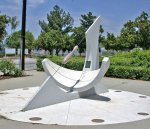 |
Claremont |
California |
USA |
Equatorial Dial |
Dial 505 |
| A 90 inch diameter spherical segment equatorial dial ten feet high of masonry construction with 3D fiberglass analemmic gnomon 40 inches long. Dial terrazzo face has hour, half-hour, quarter-hour and 5-minute marks with Roman hour numerals for PST. The 5-minute marks are one inch apart. Dial face includes analemma graphic with month dates; a plaque describes how to use the analemma graphic to select which side of the gnomon shadow to use to read time. Base perimeter has 12 ceramic plaques with Zodiacal signs.
Indicated time is accurate to one minute throughout the winter and to five minutes in summer. This is remarkable because the dial is located just outside a children's playground and children routinely climb on the dial and swing from the gnomon. An animation from digital images showing the gnomon shadow motion over the course of a full year is available.
Dedicated as the Ralph B. Larkin Memorial Sundial. Rev. Larkin was a retired missionary who taught science to children for 17 years in Claremont. Dr. Larkin's father was Edgar Lucien Larkin, Director of the Mt. Lowe Observatory above Los Angeles 1900-1924 using a 16-inch Alvan Clark refractor telescope, described by Alvan Clark as, "the finest telescope I ever made." Ralph Larkin often said, "I grew up with a telescope." The Mt. Lowe Observatory was destroyed in a windstorm in 1928 and the Alvan Clark refractor was moved to Ricard Observatory at the University of Santa Clara, California. |
| |
| |
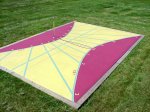 |
Hillsborough |
New Jersey |
USA |
Obelisk or Vertical Gnomon |
Dial 504 |
| A gnomonic horizontal dial constructed in bright colors on a 20 by 14 foot concrete pad. The gnomon is a vertical steel pipe 1 meter tall with a small nodus at the top. Hour lines are marked within summer and winter solstice and equatorial lines. The dial is marked with both standard and daylight local solar time. The noon line is complemented by its analemma with the months labeled. The sundial is used by Sunnymead School to aid in the science curriculum. The sundial was designed and created by Michael Folsom-Kovarik as an Eagle Scout project. Construction began on July 20, 2002 and ended on June 28, 2003. Michael was approached by Paul Stockman (the Home and School Association's treasurer) with the idea of building a sundial at Sunnymead School. Michael then came up with the design (made to keep the sundial as a useful teaching tool for the entire school day no matter what time of year) and location. After a year and a half from planning to completion, Sunnymead Elementary has a working and accurate sundial! |
| |
| |
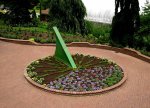 |
Wheaton |
Maryland |
USA |
Horizontal Dial |
Dial 503 |
| A 20 foot diameter horizontal dial in the middle of a brick patio. The gnomon, about 12 inches wide and 8 feet tall, is made of thin wood painted a verdant green and edged with molding. The dial face is a bed of flowers with hour lines of small plants, all immaculately kept by gardener and dial builder Roger Haynes. Around the circumference of the dial are Arabic number placards for each hour from 6am to 6pm. The flowers are changed seasonally for a gardener?s delight, and during the winter when the plants are dormant, the gnomon is removed and the area is used for a winter light show. |
| |
| |
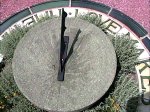 |
Colorado Springs |
Colorado |
USA |
Horizontal Dial |
Dial 500 |
| An old horizontal dial approx 60 cm diameter. From 1914-1967 was located at Marksheffel Garage, relocated to Monument Valley Park in 1967. The builder may have been van Briggle Pottery, but its history is more complex: The angles of the hour lines are consistent with a latitude of 43.9° (roughly) but the present location is 38.9°. A gnomon (probably not original) was cut for 34° lat, but has now been corrected. Likewise, the whole dial had to be rotated to true north, being off by some 47°. Hour lines have eroded, and those before 6am and after 6pm radiate from the wrong side of the gnomon. The city has spent a considerable amount of money cleaning up the area, removing the shrubs that blocked sunlight and building a nice brick wall with flowerbeds, so the area looks better, but the dial is worse than ever, with vandals bending the gnomon. |
| |
| |
 |
Colorado Springs |
Colorado |
USA |
Vertical Dial |
Dial 499 |
| A vertical dial approximately one meter square, built into the wall of the 1907 Van Briggle Pottery building. This Memorial Pottery building was erected after Artus Van Briggle's death. The Van Briggle Pottery Company is now using the Midland Railway roundhouse at Hwy 24 and 21st. In addition to hour lines with Roman numerals, surrounding tiles have pictures of the zodiac. In 1994 Colorado College repaired the gnomon and added a metal equation of time plate. |
| |